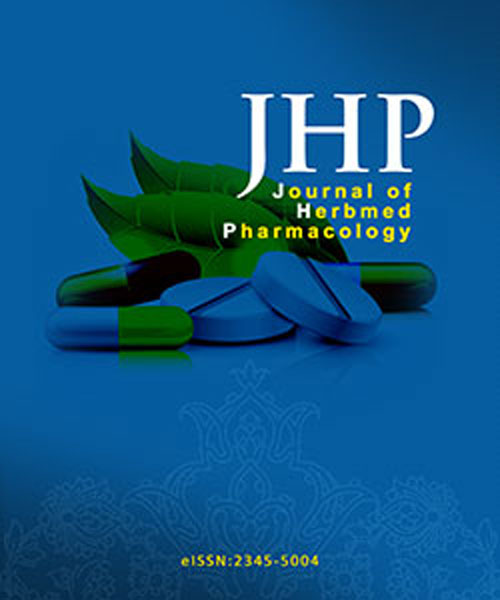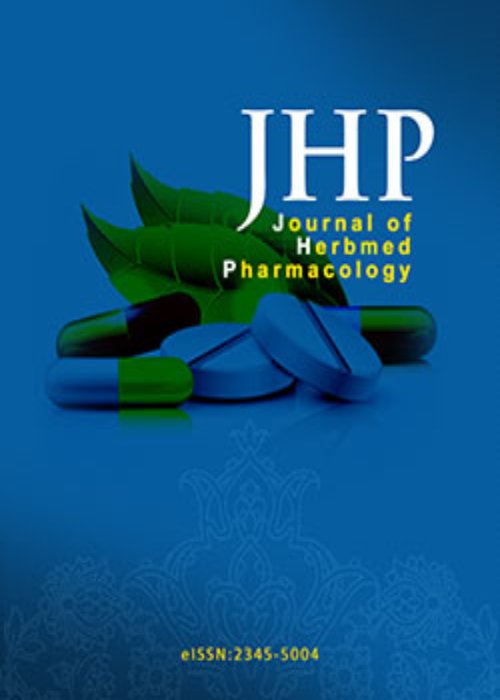فهرست مطالب

Journal of Herbmed Pharmacology
Volume:6 Issue: 4, Oct 2017
- تاریخ انتشار: 1396/07/10
- تعداد عناوین: 9
-
-
Pages 141-147IntroductionAegle marmelos (L.) Correa is an important medicinal plant, commonly known as Bael which is belonged to family Rutaceae. It is widely distributed in Asian countries. According to the literature, various chemical constituents and pharmacological effects have been reported for this plant. In Ayurvedic and traditional medicinal systems, different parts of A. marmelos are used for diabetes mellitus. In the present review, an attempt was made to summarize the in vivo and in vitro studies and clinical trials conducted to evaluate or validate the anti-diabetic activity and toxicity of A. marmelos.MethodsPubMed, Science Direct, Google Scholar, Directory of open access journals (DOAJ), EMBASE, and Web of Science were searched using the keywords Aegle marmelos and diabetes.ResultsAnti-diabetic potential, clinical applications of different parts of A. marmelos and possible toxic effects have been revealed in A. marmelos extract.ConclusionAegle marmelos can be used as a potential candidate for diabetes mellitus.Keywords: Aegle marmelos, Diabetes Mellitus, Clinical, Toxicity
-
Pages 148-152IntroductionOver centuries, Carica papaya (papaya) has been used as a nutritious and medicinal plant. In view of its medicinal uses, our group focused on aqueous leaves extract of papaya and tried to determine its antimicrobial (using bacterial strains i.e. gram positive and gram negative ones) and anti-inflammatory (virally infected human whole blood) activities. The protein content of the plant and its secondary metabolites were also analysed qualitatively.MethodsThe protein content from aqueous leaves extract of C. papaya was quantified using Nanodrop method. ELISA studies were conducted in order to determine the antibody production against ovalbumin (OVA) using papaya aqueous leaves extract. Also, its antigen specific proliferation in virally infected human whole blood samples was determined through MTT assay. In addition, antimicrobial studies (using gram positive and gram negative strains) and cytotoxicity were also studied.ResultsThe aqueous leaves extract of papaya showed enhancement in protein content and also raised antibody production against OVA. In addition, aqueous extract also showed decline in bacterial population and proliferation rate at higher doses as compared to control group. In contrast, aqueous extract showed anti-inflammatory and antimicrobial activities at higher doses.ConclusionThe aqueous leaves extract of papaya plant showed anti-inflammatory and antimicrobial activities. Hence, it might be used for preparation of a new drug for these purposes.Keywords: Carica papaya, Ovalbumin, Antimicrobial activity, Anti-inflammatory activity
-
Pages 153-159IntroductionAuristatin and its derivatives (synthetic analogues of dolastatin 10, an antineoplastic natural product), are highly potent antimitotic agents which have attracted considerable attention because of their cytotoxic activity when targeting tumor cells in the form of antibody-drug conjugates (ADCs). Some sophisticated and expensive equipment such as HPLC are needed for drug/linker isolation. The aim of this study was to provide a simple aqueous work-up procedure for the isolation of such drug/linker constructs. The anti-tumor activity of the extracted drug/linker was also investigated against SKBR3 and HEK293 cancer cell lines, and cell viability was assessed.MethodsIn the present study, monomethyl auristatin E (MMAE), a derivative of the cytotoxic tubulin modifier auristatin E, was covalently coupled to maleimidocaproyl-valine-citrulline-p-aminobenzoyloxycarbonyl (MC-vc-PAB), a cathepsin-B-cleavable linker, to obtain MC-vc-PAB-MMAE (vc-MMAE). Afterwards, a non-chromatographic isolation procedure was developed to isolate the drug/linker (vc-MMAE) construct. Silica gel thin-layer chromatography and electrospray ionization mass spectrometry were used to monitor the isolation procedure and to confirm the coupling of the linker to the drug, respectively. Further, the anti-tumor activity of the extracted drug/linker was investigated against SKBR3 and HEK293 cancer cell lines, and cell viability was assessed.ResultsAfter coupling, the isolation process was confirmed as a single spot on the TLC plate. The isolation yield was calculated to be 65%. [M H], [M 2Na] and [M ACN 2H] species were observed in the mass spectra, showing that the coupling of MMAE to the linker is not adversely affected by the workup method. Our data revealed that the isolated vc-MMAE was highly potent against tumor cell lines, exhibiting that the workup procedure did not affect MMAE-mediated cytotoxicity.ConclusionThe isolation method described in this study can be applied for the development of a wide variety of ADCs.Keywords: Isolation, Drug-linker conjugation, Dolastatin, Antibody-drug conjugate
-
Pages 160-164IntroductionInocutis levis is a polypore fungus belonging to Hymenochaetales of basidiomycetes. The specie is mainly distributed in Asia and grows on living angiosperm trees. This study investigates the effect of aqueous extract of I. levis on insulin resistance and glucose tolerance in high sucrose fed (HSF) rats.MethodsMale rats were given 30% sucrose solution for 12 weeks. The extract of I. levis at doses of 50 and 150 mg/kg body weight was intraperitoneally administered for 2 weeks in HSF rats. Blood glucose, serum insulin, insulin resistance index (HOMA-IR) and histological changes of pancreas were evaluated.ResultsSucrose solution significantly increased the insulin, glucose and HOMA-IR levels, compared to the control. At the dose of 50 mg/kg the extract decreased glucose and insulin, and improved insulin resistance relative to that of HSF rats which did not take the extract. Histological studies on pancreas tissue indicated no significant difference in the size of Langerhans islets of HSF rats and HSF rats treated with the extract at dose of 50 mg/kg compared to the control group. But, treatment with the dose of 150 mg/kg of I. levis increased islets diameter and number of cells in the islets of Langerhans in HSF group.ConclusionInocutis levis extract may have hypoglycemic effects, by regulating insulin secretion and improving glucose tolerance, and seems to be able to ameliorate pancreatic islets in HSF rats. Our findings indicate that I. levis can be considered as a potential treatment with medicinal properties to alleviate insulin resistance and to prevent risk of type 2 diabetes in a dose dependent manner.Keywords: Insulin resistance, Inocutis levis, Sucrose solution, Islets
-
Pages 165-170IntroductionAbout 50% of women are diagnosed with an episode of vulvovaginal candidiasis (VVC) during first 25 years of their lives. Candida glabrata is considered the second most prevalent non-C. albicans species associated with VVC. In this study, we examined the antifungal effect of a medicinal plant, Allium jesdianum, as a natural therapeutic agent against fluconazole-susceptible and -resistant human vaginal C. glabrata isolates, collected from 2 groups of volunteers; healthy women and women with VVC.MethodsAn aqueous-ethanolic extract of A. jesdianum was prepared by maceration method. Vaginal specimens were collected from 28 women diagnosed with VVC and eight healthy subjects. The specimens were cultured using fungal-specific media in optimum conditions. The antifungal susceptibility of clinical isolates of C. glabrata to the plant extract and fluconazole was evaluated according to the standard protocols.ResultsCandida glabrata was found to be the major cause of vaginal infection among 15.2% of women with VVC. We could identify the Candida spp. yeasts that colonized the vagina of 35% of healthy women while 19% of the isolated yeasts strains were detected as C. glabrata. Moreover, 7.1% of isolates obtained from VVC-patients were fluconazole resistant. The results showed the antifungal effect of A. jesdianum against all fluconazole resistant and susceptible C. glabrata vaginal isolates. The MIC90 of aqueous-ethanol (A-EtOH) extract of A. jesdianum against C. glabrata isolates from both VVC-patients and healthy women was 3 mg/mL.ConclusionOur results showed the promising antifungal efficacy of aqueous-ethanolic extract of A. jesdianum. A. jesdianum extract might be used as an alternative choice to treat the VVC infections caused by fluconazole resistant Candida spp.Keywords: Allium jesdianum, Antifungal, Vulvovaginal candidiasis, Fluconazole, Candida glabrata
-
Pages 171-177IntroductionAlchornea cordifolia is widely used in Nigeria for the treatment of malaria. This study was aimed at assessing the in vivo antimalarial activities of the extract and fractions (n-hexane, chloroform, ethylacetate, butanol, aqueous) of the A. cordifolia in Plasmodium berghei infected mice as well as the antioxidant potentials of the crude extract and its fractions.MethodsAntioxidant activity was assessed by 1,1-diphenyl-2-picryl-hydrazyl (DPPH), nitric oxide scavenging, reducing power and hydrogen peroxide assays. By orally administering the extract (120 mg/kg, 240 mg/kg and 360 mg/kg) and fractions (240 mg/kg), antimalarial activities were evaluated using suppressive, prophylactic and curative tests. Chloroquine (5 mg/kg), pyrimethamine (1.2 mg/kg) and artesunate (5 mg/kg) were used as positive controls.ResultsThe crude extract showed a significant (PConclusionAlchornea cordifolia exhibited significant antimalarial and antioxidant potentials, which may be useful in the on-going fight against malaria.Keywords: Antiplasmodial, Alchornea cordifolia, Plasmodium berghei, Antioxidant
-
Pages 178-184IntroductionThis study was aimed to investigate the effect of a 12-week aerobic training protocol and treatment with Glycyrrhiza glabra extract on serum interleukin 1 beta (IL-1β) and tumor necrosis factor alpha (TNF-α) levels and cognitive state in the elderly with mild cognitive impairment (MCI).MethodsForty people who attained scores 21-25 on the MiniMental State Examination (MMSE) were selected by purposive and convenience sampling and randomly assigned to four groups of 10 each: training, G. glabra-treated, training. glabra-treated, and placebo. All interventions were conducted within 12 weeks. Aerobic training protocol consisted of an 8-minute running at an intensity of 75%-85% maximum heart rate in the first session. One minute was added to the duration of running per two sessions so that after 12 weeks, the duration of running in two last sessions was 26 minutes. G. glabra extract was orally administered in 200 mg/kg body weight capsules per day.ResultsIL-1β and TNF-α levels significantly decreased in training and G. glabra-treated groups but their decrease were more marked in training. glabra-treated group (PConclusionConsumption of G. glabra extract with aerobic training for 12 weeks can slow down or stop the progression of MCI in the elderly through improving their cognitive states probably via decreasing inflammatory factors.Keywords: Aerobic training, Glycyrrhiza glabra, Cognitive state, Inflammation, Cognitive impairment
-
Pages 185-190IntroductionThe main purpose of this research was to evaluate larvicidal effects of two native medicinal plants in Iran including seeds of Ajwain (Trachyspermum ammi) and leaves and shoots of Blue Mint Bush (Ziziphora clinopodioides) against larvae of Anopheles stephensi. Their phytochemical compounds of essential oils were also determined using GC-MS method.MethodsThe plants were collected from various regions of the country in the spring of 2013, and the aqueous essential oils were prepared using a Clevenger apparatus. The standard WHO method for anti-larval experiments against third and fourth instar larvae of A. stephensi was employed at the Biometric Laboratory next to the Culicidae Insectarium at the School of Public Health of Tehran University of Medical Sciences.ResultsThe LC50s (lethal concentrations to kill 50%) and LC90s of the essential oils were 14.26 and 39.54 ppm T. ammi and 18.61 and 48.51 ppm for Z. clinopodioides. Phytochemical analysis of the essential oils of the tested plants revealed that thymol for T. ammi and pulegone for Z. clinopodioides had the highest percentage which were 71.989 and 48.609, respectively.ConclusionConsidering the results of this research, the effective compounds in these essential oils that had larvicidal properties might be used against malaria vectors.Keywords: Anopheles stephensi, Medicinal plants, Essential oils, Larvicidal effects, Malaria, Iran
-
Pages 191-195IntroductionThere is no certain result in the field of industrial pharmacy approaching to find effective drugs in prevention and treatment of atherosclerosis, like the control of lipid factors that are major risk factors of atherosclerosis. This study was designed to evaluate the effects of Gundelia tournefortii on atherosclerosis biomarkers by measuring some biochemical factors and formation of fatty streaks.MethodsIn this preclinical study, 20 male rabbits were randomly divided into 4 groups as normal diet, cholesterol diet, normal diet supplemented with G. tournefortii extract, and cholesterol diet supplemented with G. tournefortii extract. Fasting blood samples were taken at the first and end of the study. Lipoproteins, Apo lipoproteins, fasting blood sugar (FBS), low density lipoproteins (LDL), factor VII and C-reactive protein (CRP) were measured. For each animal, histopathology of right coronary artery, left coronary artery and aorta were also studied.ResultsSignificant decrease in the fatty streak formation was observed in the group receiving cholesterol-rich diet supplemented with G. tournefortii. There were not any significant changes in measured biochemical factors except for significant reduction in factor VII when G. tournefortii was supplemented with high cholesterol diet.ConclusionGundelia tournefortii decreases atherosclerosis in hypercholesterolemic diet especially by decreasing coagulating factors like factor VII. Hence, it might be beneficial in prevention of atherosclerosis.Keywords: Gundelia tournefortii, Atherosclerosis, Cholesterol, Fatty streak


